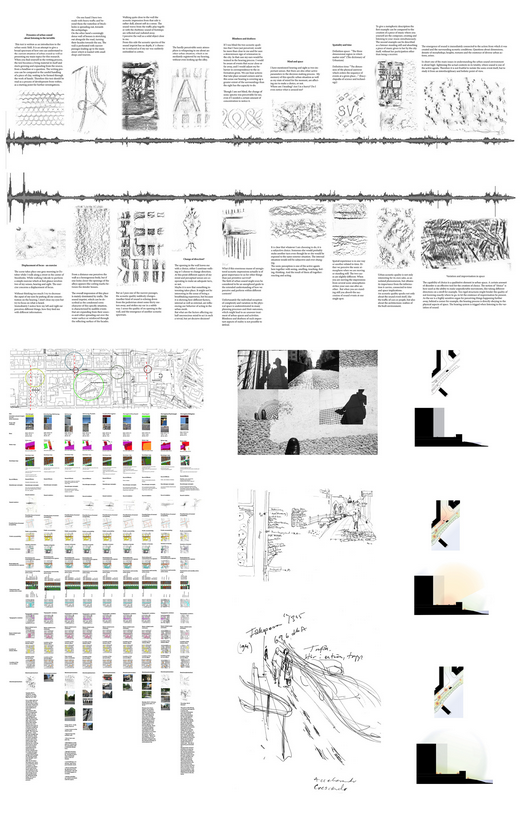POSTPONED until January - Nina Hällgren (Final Seminar, Dec 4)
Opponents:
Monica Sand, artist, researcher and research coordinator at Swedish Centre for Architecture and Design, ArkDes
Ricardo Atienza architect, sound artist, researcher and teacher at Konstfack
Tid: Fr 2015-12-04 kl 13.00 - 17.00
Plats: KTH–A Konferensrum A608, plan 6, Osquars backe 5, Stockholm
ABSTRACT:
We live in a globalized and quickly urbanizing world. Challenges that we may encounter in one corner of the globe can sometimes be transposable to similar situations in other cultural and geographical contexts making certain challenges into universal problems to solve. The problem of too much, too monotonous and too intense sound in dense urban environments can be regarded as one such problem. In times when new cities emerges like mushrooms from the ground and existing cities gets all the more condense it is urgent to find solutions to what we can do in order to obtain sustainable life environments for half of the world´s population now living in cities. The challenge of finding viable solutions to this question is today starting to become an urgent topic among several national and international commissions, organizations, policy makers and other stakeholders. Increased attention to the quality of the urban sonic environment is one important aspect that needs to be taken into consideration in this knowledge development.
Urban sonic environments i.e. complex architectural spaces including its shifting and multilayered sonic qualities is directly connected to matters of health, equality and equity which require a broad and integrative understanding and treatment by concerned professionals, organizations, policymakers and other concerned stakeholders to be adequately handled.
The phenomenon of sound in the urban environment is always bound to a spatial context (architecture), the events taking places there (activities) in relation to temporality (sound propagation, movement, time of the day, seasons, distance between sound sources etc.) and the act of listening and participating at that course of events through ones bodily presence (experience).
In a sustainable and democratic city everyone has access to variegated urban sonic spaces within ones physical reach and is not unwillingly exposed to persistent and monotonous sonic qualities over extensive time durations. Such an environment is also characterized by the existence of a pluralistic range of urban spaces containing a plenitude of distinct, contrasting and multilayered sonic qualities.
However, a lingering idea among concerned stakeholders, policy makers and practitioners working with the physical creation of life environments, is that sound in urban context is equivalent with noise which is equivalent with problems that we have to be protected from through defensive strategies a conviction that unfortunately still dominates common debates and the field of practice.
An assumption is therefore that we need to increasingly develop communicative means of description and representation to be able to share knowledge on the qualitative aspects of sound in urban space and learn more about how to jointly work with the immaterial materiality of sound as an incitement for decision-making in planning and design processes in order to get operative.
Methods and tools for grasping, describing and communicating the matter of sound in complex architectural spaces in relation to and sonic experience, is what the thesis Urban Sound Planning and design – methods for qualitative sound analysis of complex architectural spaces is trying to unfold. By choosing one of Stockholm most air and noise-polluted streets for an explorative study on urban sound quality, the intent has been to grasp and show existing variations of spatio-sonic qualities found within that urban space. Through the use and development of qualitative and quantitative means of description, representation and analysis (the tactics), I also question the widespread use of noise maps as the sole communicator of urban sound quality currently functioning as the only basic sonic data for operative action. The noise map is too rough and too general to be used as the sole descriptor of urban sonic space. By showing that it is possible to develop complementary ways of approaching this topic that are both structural as well as sensorial, descriptive as well as operative, qualitative as well as quantitative, generic as well as specific, the intent is to open up for further transdisciplinary discussions, practice and research in this field.
Nina Hällgren is an architect with particular interest in the qualitative dimension of architecture. Her research focus concerns the sonic aspect of everyday urban space and the question how it is possible to communicate and work creative and practically with the qualitative aspect of urban sounds from a practice-oriented and transdisciplinary perspective.
The doctoral studies have been pursued at KTH School of Architecture in collaboration with Konstfack University College of Arts, Crafts and Design.

